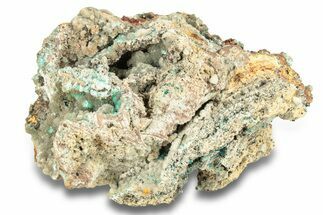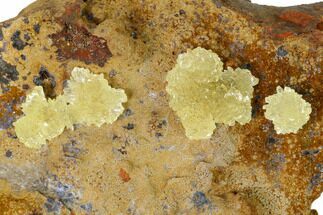This Specimen has been sold.
2.8" Fibrous Aurichalcite Aggregations with Bladed Calcite - Mexico
This specimen features beautiful aggregations of fibrous aurichalcite crystals that formed in association with bladed calcite crystals, collected from the Ojuela Mine in Durango, Mexico.
About The Ojuela Mine
Ojuela is not one mine but a complex of multiple mines in the same general area, located just northwest of Mapimi, Mexico. It was established in 1598 after the discovery of an old abandoned silver and gold mine. As mineral production increased and the mineral potential was confirmed, the town (Ojuela settlement) adjacent to the mine, along with the city of Mapimi, began to grow as well. The mining settlement was such a success that it contained a post office, warehouses, stores, saloons, a church, and housing for the miners. Once minerals were collected, they were processed in Mapimi, which also played a role in the rapid development of the city. Around the start of the 20th century, most of the mineral deposits were exhausted, resulting in the abandonment of the mines and settlement.
The mine is well known by mineral collectors for its aresenate minerals and a variety of other mineral species: approximately 117 have been identified from the area. Some of the most popular minerals include adamite, austinite, hemimorphite, scorodite, platternite, aurichalcite, rosasite, calcite, wulfenite, mimetite, iridescent goethite, and fluorite.
Ojuela is not one mine but a complex of multiple mines in the same general area, located just northwest of Mapimi, Mexico. It was established in 1598 after the discovery of an old abandoned silver and gold mine. As mineral production increased and the mineral potential was confirmed, the town (Ojuela settlement) adjacent to the mine, along with the city of Mapimi, began to grow as well. The mining settlement was such a success that it contained a post office, warehouses, stores, saloons, a church, and housing for the miners. Once minerals were collected, they were processed in Mapimi, which also played a role in the rapid development of the city. Around the start of the 20th century, most of the mineral deposits were exhausted, resulting in the abandonment of the mines and settlement.
The mine is well known by mineral collectors for its aresenate minerals and a variety of other mineral species: approximately 117 have been identified from the area. Some of the most popular minerals include adamite, austinite, hemimorphite, scorodite, platternite, aurichalcite, rosasite, calcite, wulfenite, mimetite, iridescent goethite, and fluorite.
Aurichalcite (chemical formula (Zn,Cu)5(CO3)2(OH)6) is a secondary mineral that forms in the oxidation zones of copper and zinc ore deposits. It often forms as radiating, fuzzy-looking acicular blue-green crystals and linings along cavity walls.
SPECIES
Aurichalcite & Calcite
LOCATION
Ojuela Mine, Mapimi, Durango, Mexico.
SIZE
2.8 x 2.2"
CATEGORY
ITEM
#215019
 Reviews
Reviews













